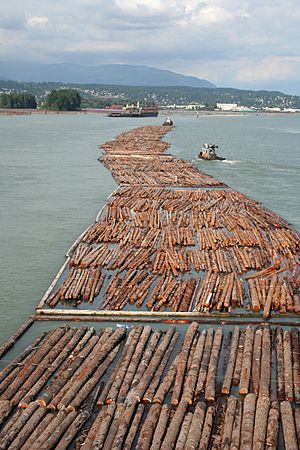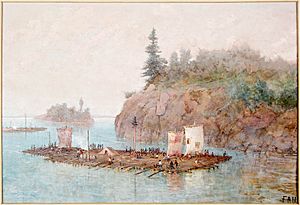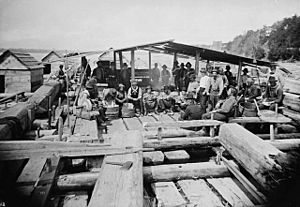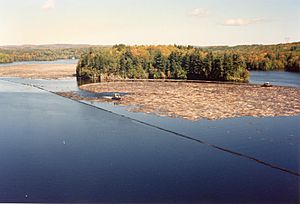Timber rafting facts for kids

Timber rafting is a way to move cut tree trunks by tying them together to make rafts. These rafts then float or are pulled down a river, across a lake, or other water. It's one of the cheapest ways to transport cut timber, second only to log driving. Both methods are sometimes called timber floating. The tradition of timber rafting is so important that it was added to the UNESCO Representative List of the Intangible Cultural Heritage of Humanity in 2022. This tradition is celebrated in countries like Austria, the Czech Republic, Germany, Latvia, Poland, and Spain.
Contents
How Timber Rafting Worked in the Past
Unlike log driving, which involved floating single logs and was quite dangerous, timber rafting offered a more comfortable journey. Raftsmen, also called floaters, could even build small cabins on their rafts. They steered with large oars and could stop along the way. However, rafting needed wider rivers than log driving.
Timber rafts were not just for logs. People also used them to transport other things. These included raw materials like ore, fur, and food, as well as items made by people.
Long ago, the ancient Romans used huge rafts to bring timber from Corsica. A writer named Theophrastus recorded that one such raft had as many as fifty masts and sails!
This method of transport was once very common around the world. It was especially popular in North America and on the main rivers of Germany. Timber rafting helped connect large forests, like those in southwestern Germany, to cities and states along the coast. Rivers like the Main, Neckar, Danube, and Rhine were like highways. For example, large pine trees from the Black Forest were called "Holländer" because they were traded all the way to the Netherlands.
Some of the biggest timber rafts on the Rhine River were incredibly long. They could be 200 to 400 meters (650 to 1,300 feet) long and 40 meters (130 feet) wide. These rafts held thousands of logs. A crew of 400 to 500 people lived on these rafts. They had shelters, bakeries, ovens, and even places for livestock. This system created a huge network across Europe.
Over time, new ways of transport appeared. Railroads, steam boats, and better roads with trucks made timber rafting less common. However, it is still important in Finland today. In Spain, this method was used on rivers like the Ebro and Tajo until the mid-1900s. In Russia, very large timber rafts called belyana were used into the 1930s.
Building a Timber Raft
Timber rafts could be enormous. Some were up to 600 meters (nearly 2,000 feet) long and 50 meters (164 feet) wide. Logs were stacked up to 2 meters (6.5 feet) high. These giant rafts could carry thousands of logs. For the comfort of the raftsmen, who could be as many as 500, logs were also used to build cabins and kitchens. The rafts were steered using large oars, and later, by tugboats.
How a raft was built depended on the river. On rocky and winding rivers, rafts were designed to be flexible. For example, the front parts of the logs might be tied tightly. But the back parts were loosely roped together. This allowed the raft to bend and adapt to narrow, curvy parts of the river. On wide, calm rivers, like the Mississippi River, huge rafts could travel together. They sometimes even linked up into long chains.
Special log rafts for long-distance travel appeared on the Atlantic coast around 1883. These were sometimes called Joggins-Leary log ships. Similar large rafts were also used on the Rhine River. On the Pacific coast, companies like the Pacific West Coast Joggins Raft Company also started using these large rafts.
Timber Rafting in the Southeastern United States
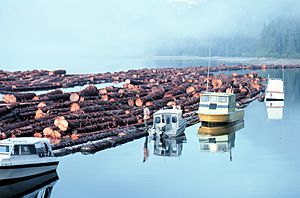
Rafting was a main way to move timber in the southeastern United States. However, except on the Mississippi River, these rafts were smaller. For example, on Georgia’s Altamaha River, rafts could be no wider than about 12 meters (40 feet). This was because they had to fit between railroad bridge supports. The longest they could be was about 76 meters (250 feet). This length allowed them to navigate "The Narrows," a very narrow and crooked part of the river.
Each raft had two long oars, about 12 to 15 meters (40 to 50 feet) long. One was at the front (bow), and the other at the back (stern). These oars were for steering, not for making the raft move forward. A raft needed at least two men: the pilot, who usually handled the stern oar, and his helper at the bow. Rafts often had a simple lean-to shack for shelter. They also had a pile of dirt for a hearth, where raftsmen could warm up and cook.
The timber rafts on the Altamaha River carried logs to the port of Brunswick, Georgia. From there, the logs were loaded onto ships called timber schooners. These ships then took the timber to international markets. Important destinations included Liverpool, Rio de Janeiro, and Havana. Rivermen gave colorful names to different places and dangers along the Altamaha. One difficult spot was called Old Hell Bight. It was a very tricky bend with strong currents. Pilots and crews could lose their wages, their timber, and sometimes even their lives there.
Most rafts had a V-shaped front, called "sharp-chute," instead of a square front. Raftsmen learned that a V-bowed raft was more likely to stay together. If it went out of control and hit the river bank, it would often just bounce off. An old raftsman explained: "With a square bow, you had to keep the raft in the middle of the river. If it hit the bank, it would break apart. The sharp-chute could be built so it wouldn't come apart. And it saved a lot of hard work."
Rafts were built in sections. Each section was made of round or squared timbers. All the timbers in a section were the same length. However, the outside timbers, called "boom logs," extended a bit further back. This allowed them to connect to the next section. A typical raft might have three, four, or five sections. Each section's timbers were usually 6 to 9 meters (20 to 30 feet) long.
Most rafts used squared timbers. These were either shaped by hand with an ax or cut by sawmills. Some timbers were very smoothly shaped. There was a high demand for these, especially in England, even after steam sawmills became common. On the Altamaha, many rafts were made of "scab" timber. These were logs roughly squared with a broad ax. This made them fit together more tightly and allowed them to be cut by gang sawmills, which could only cut flat-faced timber.
While some rafting happened on the Altamaha before the Civil War and after World War I, the main rafting era was between those wars. During these years, Darien, Georgia, a town at the river's mouth, was a major international timber port. Reports of timber exports from Darien were even included in the New York Lumber Trade Journal. This put Darien alongside much larger ports like New Orleans and Savannah.
See also
 In Spanish: Maderada para niños
In Spanish: Maderada para niños
- Barrier Boat
- Belyana
- Benson raft
- Kallai
- Log boom
- Log driving
- Log flume
- Timber slide
- Wood economy
- Eight Hundred Leagues on the Amazon, a novel by Jules Verne about a timber raft trip down the Amazon River.


